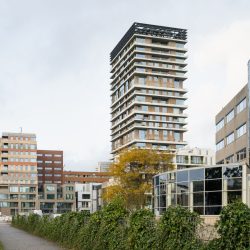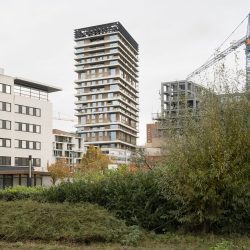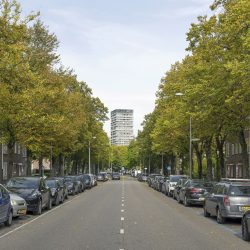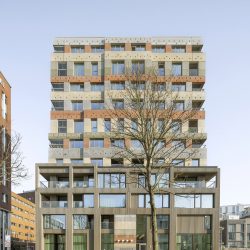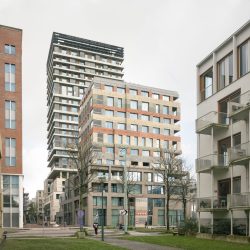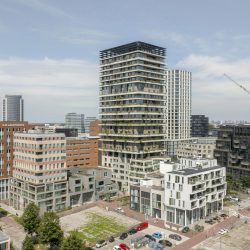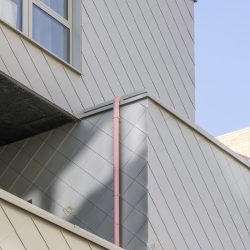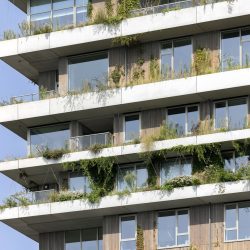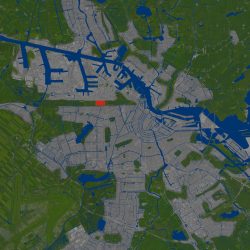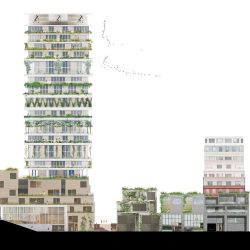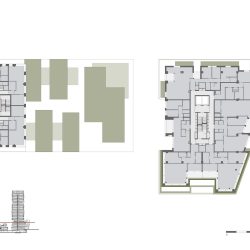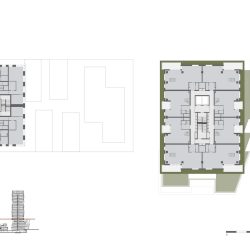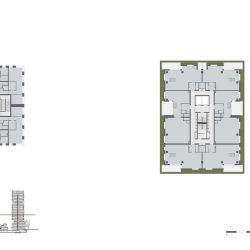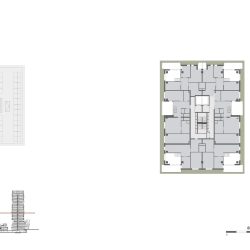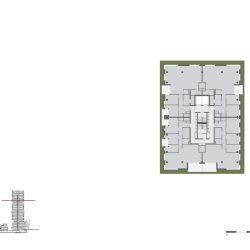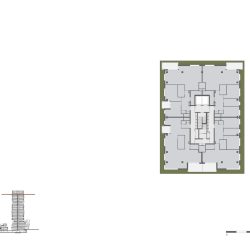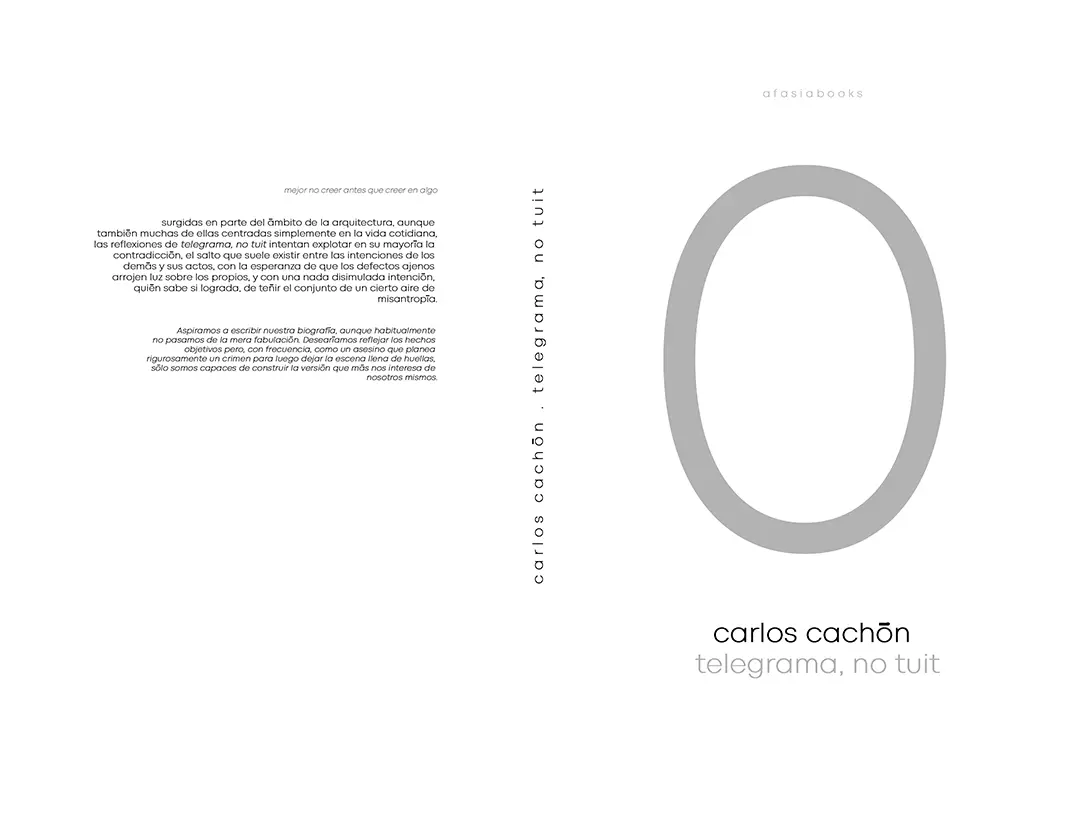
NL Architects . Space Encounters . Studio Donna van Milligen Bielke . Chris Collaris (i29 Architects) . VDNDP
VERTICAL is the highly ambitious endeavor to catalyze the transformation of the Sloterdijk business district from monofunctional office park into a lively mixed-use neighborhood.
VERTICAL is the collaborative and optimistic effort of Team Heijmans to introduce ‘life’ in many as many ways as possible to an at first glance rather hostile environment. How can we stimulate inspiring forms of cohabitation?
Setting
Sloterdijk is a business district in the west of Amsterdam at the intersection of three railway lines and the ring road around Amsterdam. The so-called ‘Teleport’ came into being in the 1980s as a Dutch variant on La Defense. The area is dominated by office buildings -some of which have recently been converted into hotels- and by rather fascinating large scale infrastructure. The ‘non-stick’ architecture feels defensive and inaccessible, its appearance largely defined by granite and mirror glass. Generic City. How can we make this counter-intuitive environment suitable for living?
The urban plan by DOOR architecten serves as the foundation for intensifying the area: the plan introduces a dynamic blend of new building masses on the remaining vacant plots and proposes a diversified, lively plinth to evoke a maximum of interaction. The base follows the fluidity of the infra-landscape and is topped by an objective grid of north south oriented towers with stunning views over the harbor and the city. ‘Mies’ on top of ‘Jane’.
Biotope
VERTICAL is situated in the so-called Brettenzone, one of the famous green lobes (or ‘fingers’) that allow the landscape to penetrate into the urban tissue of Amsterdam, contributing greatly to the city’s livability. On the heatmap of Amsterdam however, Sloterdijk shows up as a red square interrupting this green band into the city center. The ambition is to remove this ‘blood clot’ by introducing an intricate system of vegetation and water storage. As such the project could be understood as a vertical version of the sequence of landscapes that forms the Brettenzone and that as such hopes to restore a degree of ecological continuity.
Habitat
Since Kavel N is the first residential development in this part of the city, the strategy was to introduce a wide range of dwelling sizes. VERTICAL aimed to create a complex biotope that would invite a truly diverse population. Unlike the claustrophobic monotony of the usual ‘beehive of micro units’ this extraordinary spectrum of housing types safeguards diversity from the start.
The buildings emphasize their residential function to form a counterpoint to the bland, homogeneous surroundings. They should radiate ‘living’. The varying floor heights combined with the varying heights of the floor bands in both towers introduce a vibrating silhouette that counters the standardized and predictable backdrop. At the foot of these towers a lively and partly programmed plinth emerges: diverse, permeable, interactive, transparent, friendly.
In order to substantiate the architectonic and environmental diversity in a profound manner Team Heijmans was formed into a carefully composed pool of architects: Space Encounters, Studio Donna van Milligen Bielke, Chris Collaris (i29 Architects), DS Landschapsarchitecten, VDNDP and NL Architects.
Ying Yang
VERTICAL consist of two parts, Kavel N1 in the west and Kavel N2 in the east. Together these components form a Ying Yang ecosystem of 168 dwellings; a total of 20.000 m2 of homes, amenities and lush outdoor spaces.
Kavel N1 features four distinct segments by four distinct architects. While Space Encounter’s design for the abstract, stacked boxes clad in aluminum shingles embraces air and light, NL Architect’s dark concrete brick volumes serve as a counterpoint to the lighter and brighter wooden plinth volume created by Chris Collaris (i29 Architects). This wing of the complex is topped with the ‘rocky’, monolithic residential tower by Studio Donna van Milligen Bielke. This tower houses several large and flexible lofts that each offer bi-directional orientations and views. The multilayered and -colored facades set out to create a vibrant habitat for birds, bats, and insects, as each band hosts nest boxes for specific species. The heavily planted deck on top of the double height units at grade -referred to as ‘Bretten Carpet’- forms a new ‘ground level’ that provides access to several free standing houses.
Kavel N3 features a six-story plinth with differentiated massing topped by a 17-story high-rise. The transparent ground level designed by NL Architects hosts the entrance lobby for the tower, as well as commercial and flexible spaces to accommodate initiatives that foster community engagement. On top of this glazed level, three solid and staggered sand-tone colored volumes are positioned. The integrated planters in the facade of Space Encounters makes the appearance of one corner volume allude to the architecture of Maya temples, while the volume on the opposite corner, designed by Chris Collaris (i29 Architects), introduces the abstract expression of ecological cob construction. A restrained stepped concrete brick volume crafted by NL Architects nestles in-between these cornerstones. The wood clad tower that rises above -also created by NL Architects- is conceived as a layer cake of cultivated landscapes. The floor heights differ, from standard 3 meter to the rather spectacular 4 and 6 meter floor to floor that offer a pretty unusual spatial experience. The protruding floors extend into continuous planters featuring different heights with different soil packages offering different growth conditions for the vegetation. Together these permutations seek to establish a slightly vibrating silhouette.
Shared Living
At the transition of base and tower a special amenity is introduced: the Shared Living Space, a collective living room that is open to all inhabitants of both Kavel N1 and N3. It will feature a ‘family room’ with a large kitchen and dinner table, space for reading and lounging and room to play, room that can be used for gatherings of many kinds. Additionally two guest rooms and a workout space are available, as well as the all-around roof garden for potentially infinite strolls.
Power
VERTICAL is by default sustainable. The building uses the sun, the wind and geothermal heat. Rainwater and hot water are optimally used and recycled. With the right orientation of the two towers, a well-insulated skin, a solar crown and the facility to generate passive energy from the soil, the energy demand of the building is reduced. Moreover, VERTICAL has its own thermal energy storage system.
Urban Ecology
VERTICAL is located in the compact urban cluster concentrated around Sloterdijk Station that is rather ruthlessly obstructing the continuity of one of the Cities important ecological arteries. The local government intends to dissolve this ‘blockade’ by implementing abundant greenery both on plazas and buildings. VERTICAL responds to this ambition by blending landscape and building into one, by creating a shared habitat for people, vegetation and wildlife.
On the ground-level hard, stony surfaces are kept to a minimum. ‘Facade gardens’ emerge and climbers and creepers can flourish providing a link between ground level and the heavy planting on the roofs of the lower buildings. This so-called Bretten Carpet is a reference to the specific landscape in which Sloterdijk is located and seeks to help bridge the gap between Westerpark and the ‘Bretten’.
The western apartment tower rises up from this Carpet as a permeable monolith with an assortment of carefully crafted openings offering spaces for birds, insects and bats (and humans too) to hide and to breed.
The eastern tower provides a pulsating stack of planters all around that interpret the various landscapes in the Brettenzone, from cultivated to wild: from park, allotment garden, cemetery, polder, farm, vegetable garden, sport fields, swamp, to coppice forest and dunes. Each layer is composed of a different mix of indigenous plants: a mixture of herbs, grasses, shrubs and climbers native to the Brettenzone. The vegetation serves as a confectionery for birds. The greenery offers forage in the form of fruits, berries and seeds as well as invertebrates and insects attracted by the foliage.
And the lush planting of course creates pleasant living conditions for humans as well; CO2 is captured, fine particles bound, noise impact from harbor and cars is softened and heat stress reduced.
Long-term, attentive maintenance is crucial for the success of the endeavor. The grounds keepers have to work in rather unusual conditions to optimize the growth process. And although the planting has been very carefully compiled and engineered, it should not be considered final; a responsive attitude is welcome to ensure flourishing greenery over time. A feedback-loop is instrumental in the understanding of the vegetation, so that it eventually will fully match the specific conditions of the building.
A profound involvement of the homeowners seems vital as well. A very encouraging side-effect of this essential commitment can already be witnessed in VERTICAL: the social interaction between interested inhabitants is enhanced in a natural way.
Metabolism
Amsterdam Rain Proof is a program that aspires to make the city more resistant to the increasingly frequent and increasingly heavy downpours. Amsterdam Rain Proof is now a precondition for new developments; it prescribes temporary water storage and a delayed transfer to the sewage to prevent flooding of the system. The ambition for the Sloterdijk area is that 60 millimeters of rain water can be stored on each plot for 24 hours and that the release to the sewer is slowed down to a maximum flow rate of 0,9 millimeter per hour (2,5 l/s/ha).
The roofs of Kavel N1 and N3 in principle provide the required water storage, but additionally the planters that circumscribe the ensemble substantially increase the capacity.
Water is buffered in the substrate. Additionally a system of porous crates at the bottom of the continuous flowerpots as well as on the roofs structurally contains rainwater. This water serves as the life source for the vegetation, mostly through capillary action. As soon as the weather station foresees alarmingly heavy rainfall the stored water is released into the sewage. As such the necessary buffer space is freed up. All together VERTICAl can provide 330 m3 of water storage, which is more than double the required capacity.
Some of the rainwater is captured in a large vessel inside the building. Here nutrients can be added and the enriched water is subsequently fed back into the system. In the rare case of continuous drought the survival of the vegetation can be guaranteed by adding tap water.
Planting helps to mitigate the effects of urban heating: it lowers temperatures through shade and through ‘evapotranspiration’. Plants absorb water through their roots and emit it through their leaves. This referred to as “transpiration”. Evaporation -the conversion of water from a liquid to a gas- also occurs from the soil around vegetation and from plants and shrubs as they intercept rainfall on leaves. Together, these processes are referred to as evapotranspiration.
The protruding floors of the high rise create shade. The shadow decreases evaporation during summer making sure enough water stays available in the season with the highest growth rate and the largest water demand.
All in all an intricate system of interdependencies comes into being, that will hopefully form an elegant symbiotic relationship between plant life, biodiversity, cooling and water buffering; an optimistic integral attempt at climate adaptation.
_
“Sloterdijk Kavel N1 and N3”
Amsterdam Sloterdijk, Radarweg
Tender 2017
Completion 2023
168 apartments
Gross floor area: 17500m2 of which 836 m2 commercial spaces
Concept Developer:
Heijmans Vastgoed
Architect:
NL Architects + Space Encounters, Studio Donna van Milligen Bielke, Chris Collaris (i29 Architects), VDNDP
Landschapsarchitect:
DS landschapsarchitecten
Collaborators / Consultants:
Van den Berg Bouwkundigen, De Dakdokters, Fore Installatie Adviseurs, Huisman & van Muijen, IMd Raadgevende Ingenieurs, LBP Sight, Moma & Co, Ruben Esser (Tenderboost), Van der Tol, WAX Architectural Visualizations
Contractor
Heijmans Bouw

